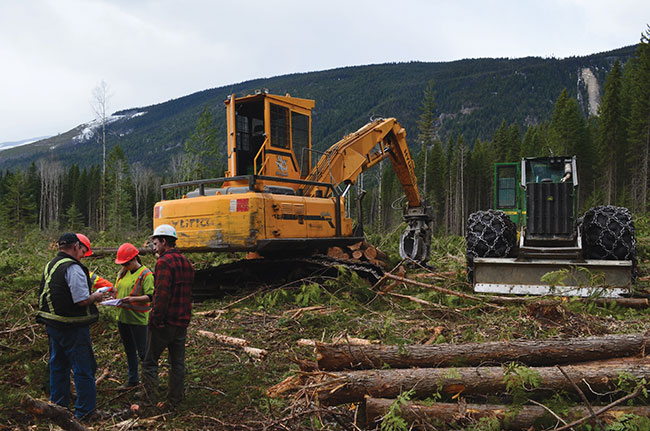
Features
Harvesting
Logging Profiles
Exit planning: The right succession strategy ensures you get the most from your business
June 1, 2021 By Chris Duncan and Brent Tolmie
 Photo: Annex Business Media
Photo: Annex Business Media The best time to plan for your exit was yesterday. The next best time is right now.
It used to be you could buy a line skidder, go out to fall a turn, hook up chokers and drag it to the landing for hand bucking. If you were working in steeper country, it wasn’t unreasonable to borrow enough money to purchase a 90-foot steel spar and a TL6 or 966C for loading. Point is, you worked with ratty mainlines, used every last millimetre of the chain life on the powersaw and begrudgingly spent money on a new crummy only when the current one was too far gone to repair.
But those days are long gone. Most contractors now need leading edge and multi-million-dollar equipment spreads to compete for slim margins and an ever-shrinking workforce.
The cost of equipment has become a barrier to entry, but at the same time, the contractors who have built companies capable of performing the work are looking to exit. Transitions are ramping up as baby boomers increasingly look toward retirement. More businesses are changing hands and many contractors are planning to exit within the next five years. Counting on cash flow to finance retirement may not be an option and it’s a good time to think about the mechanics of exit.
Not so simple
The challenge of exiting a contracting company can be manifold. Many owners don’t have a clear successor. The industry workforce is aging, and the younger generation is increasingly disinterested in entering the industry. There isn’t a lot of consolidation activity going on right now – and those who are keen to take over lack the capital required to buy shareholders out.
To prepare for your eventual exit, it’s best to know what exit options look like. But before that, it all starts with understanding the time factor.
Time can be your friend
Getting a company ready for transition takes time. Just like selling a house or a car, preparation is vital. With a car, it means performing all routine maintenance, getting your service records in order, and thoroughly cleaning it inside and out. With a house, it’s ensuring you’ve done all the pesky renos, made sure the switch plate covers are on straight and the flower garden is weed-free.
You put a lot of effort in presenting your assets in the best light – you should do the same for your business. Create a situation where you know a potential buyer will see a clean, well-managed operation when they come to poke around. All the legacy issues are put to bed and your financials are clean and well laid-out.
As with the auto or home sale, multiple offers are highly desirable. Well-presented companies attract investors who are confident they can rely on your systems, cash flow, team, brand and culture to create future reliable revenue streams.
Time can be your enemy
Just as preparation helps ensure a favourable result, not having enough time can have the opposite effect. Even worse, not allowing yourself enough runway may cause business fatigue – a premature exit where you accept terms below your enterprise value just to get the deal done.
As logging contractors, you know all too well how lonely it can be to carry the risk and responsibility of running a business. Many people shoulder the weight effortlessly for years, but everyone has their breaking point. We roll with the challenges, but enough eventually becomes enough. Problem is, too many people put off planning until they feel the need to exit. And by that time, some are willing to get out at any cost.
This panic to exit can act as a negative force multiplier. Since businesses generally sell for a multiple of EBITDA (earnings before interest, taxes, depreciation, and amortization), becoming disillusioned and letting revenue decline often allows a buyer to offer on a lower multiple. They see the business is on a downslope and are therefore less certain it can generate sufficient cash flow to justify the investment, so they hedge by discounting for risk.
Say your EBITDA has recently dropped from $2 million to $1.5 million. A buyer may look at the decline, note your lack of enthusiasm and decide they’d feel more comfortable offering a three times multiple rather than the four times industry standard. What could have been an $8 million deal is now nearly halved to $4.5 million, all because of fatigue.

Photo: Annex Business Media
Time for some solutions
Begin the conversation around exiting the business early so you and your advisor can establish a timeframe and examine what you need to meet your goals. What will your next phase require? Do you want to pursue other opportunities, or is this retirement? This baseline helps you figure out how much money you need and when. Then you can determine if you have the personal assets required for the next phase or if that needs to come from the business.
This is the crux of succession planning. It helps to clarify what we need to do based on what we want to do. It could be retirement, but it’s often so much more. And once you know what you need from the business, we can look at the options for exit.
Options for exit
So, what are the options for exit? Below are the most common ways for owners to exit their business. While no option is the wrong way forward, some are more beneficial to the overall stakeholder group than others.
Selling to employees – More and more companies are setting up employee share ownership programs (ESOPs) to attract and retain top talent. Some employees are willing to share in the risk, build culture and bring the team closer together. In many cases, this can help grow top line sales and improve profitability.
Bringing the business to market – Sometimes the best way to exit is to sell. Employees may not be interested in buying or you may lack clear successors. This process can be as simple as reaching out to a competitor. Or it could be a full corporate finance engagement where a specialized team brings the company to market and solicits and fields offers.
Transferring to family – Many resource businesses are multi-generational, passed down from mom and dad to sons and daughters and beyond. The challenges are many – styles, perspectives, and ways of seeing the world change over time. We all have our own view of how to manage and this can be compounded when one generation takes over from the next.
Wind up/orderly liquidation – This ends up being an all too common option in the resource industry. The business is wound down, employees are laid off, and the assets are sold through orderly liquidation via direct sales or auction.
Remember, your stakeholders aren’t just shareholders and employees. Many people in your community and beyond may rely on your business for business and economic prosperity. These include employees’ families, suppliers, upstream and downstream parties, and local communities.
Time is your friend and knowledge is power when charting the path forward. Understanding and anticipating your challenges allows you to carve out the most enjoyable, productive, and profitable route. The first step is acknowledging that change is coming and you need to embrace it. Consider how you want your future to look; from there, you can build a transition plan that will help you meet your goals and exit on your terms.
Chris Duncan, CPA, CA, is national leader of forestry and forest products at MNP. For strategies and advice to increase the value and performance of your business, contact Chris at 250.856.2443 or chris.duncan@mnp.ca. Brent Tolmie, MBA, ICD.D, PMP, is senior manager, succession services at MNP. To learn more about planning for succession and how to maximize your return on an exit, contact Brent at 778.72.0570 or brent.tolmie@mnp.ca.
Print this page